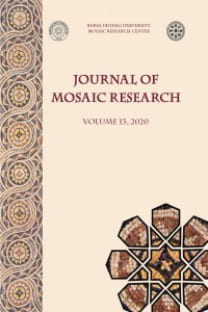Harcın Teknolojisi ve Bileşimi ile Taşın Kökeni ve Parthicopolis’teki Erken Hıristiyan Mozaiklerinin Smalta Tesserası. Orta Strymon’daki Antik Mozaiklere İlişkin Veri Tabanının Başlangıcı
Bu makale, Makedonya I eyaletinde önemli bir piskoposluk merkezi olan Parthicopolis’teki 2 numaralı bazilikanın ekzonarteksinin mozaik döşemesinin mermer, kumtaşı, tuğla ve smaltadan yapılmış harç ve tesseralarının incelenmesinden elde edilen sonuçları sunmaktadır. Uygulanan yöntemler makro ve mikro analizdir, ayrıca mineral fazların SEM-EDS ve XRD analizi yöntemleri de kullanılmıştır. Mozaiğin, statümen ve rudus içermeyen harç tabakası üzerine döşendiği tespit edilmiştir. Harcın incelenmesi, tesseralar arasında ince bir fraksiyonu, harcın bileşimindeki kireç topaklarını ve ince bir tuğla tozu ile güçlendirildiğini ortaya koymaktadır. Mermer ve kumtaşından tuğla ve taş tesseralar yerel kökenlidir ve cam tesseralar için smalta, muhtemelen sahada ikincil işlemden geçirilerek ithal edilmiştir. Smaltanın bileşiminde şu teknolojik süreçler tespit edilmiştir: ikincil ısıtma, büyük miktarda küçük balon, eritme, kalıplama, tavlama veya sodyum-kireç-silikat camın ikincil işlenmesi sırasında istenmeyen kristalin safsızlıklar. Bu durum, yerinde yeniden üretilen mamul üretimin ithal edilme olasılığını ortaya koymaktadır. Çalışma, mozaikçiler hakkında, süreçlerin özü, yerel malzemeler kullanarak istenen sonucu elde etmeyi başardıkları zengin teknik beceri cephaneliği hakkında çok derin bir bilgi birikimi oluşturmuştur.
Anahtar Kelimeler:
Mozaikler, harç, tesseralar, yerel üretim ve ithalat, köken
Technology and Composition of the Mortar and Origin of the Stone and the Smalta Tesserae of the Early Christian Mosaics from Parthicopolis. The Beginning of Database on the Ancient Mosaics from Middle Strymon
The article presents the results of a study on the mortar and tesserae made of marble, sandstone, brick, and smalta in the mosaic pavement of the exonarthex of Basilica No. 2 in Parthicopolis. This basilica served as an important episcopal center in the province of Macedonia I. The methods employed include macro- and micro-analysis, as well as SEM-EDS and XRD analysis of the mineral phases. It has been established that the mosaic was laid on a mortar layer without a statumen and rudus. The study of the mortar revealed the presence of a fine fraction among the tesserae, as well as lumps of lime in the mortar composition, which were reinforced with a fine brick powder. The brick and stone tesserae, including marble and sandstone, originated locally, while the smalta used for the glass tesserae was imported, possibly undergoing secondary processing on-site. The analysis of the smalta composition identified several technological processes, including secondary heating, a significant presence of small air bubbles, and unwanted crystalline impurities. These phenomena likely occurred during the melting, molding, annealing, or secondary processing of sodium-lime-silicate glass. This suggests the possibility of imported manufactured production being remade in situ, demonstrating the utilization of local materials and techniques. The study revealed that the mosaicists possessed a profound understanding of the craft, including a deep knowledge of the underlying processes and a diverse range of technical skills. With this expertise, they were able to successfully achieve the desired result by utilizing local materials.
Keywords:
Mosaics, mortar, tesserae, local production and import, provenance,
___
- Devulder - Degryse 2014 V. Devulder - P. Degryse, “The Sources of Natron”, P. Degryse (ed.), Glass Making in the Greco-Roman World, Results of the ARCHGLASS Project, Leuven, 87-96.
- Georgieva et al. 2003 R. Georgieva - E. Kashchieva - Y. Kolchakov - Y. Dimitriev - B. Samuneva, “Thermal Properties and Microstructure of Roman Flat Window Glass Found in Bulgaria”, Journal of Non-Crystalline Solids 323, 143-146.
- Ivanov et al. 1969 T. Ivanov - D. Serafimova - N. Nikolov, “Razkopki v Sandanski prez 1960 g.”, Izvestia na arheologicheskia Institut, BAN, XXXI, 109-205.
- Jackson 2005 C. M. Jackson, “Making Colourless Glass in the Roman Period”, Archaeometry 47, 4, 763-780.
- Petrov 1982 B. Petrov, “Dekorativnite mramori ot nahodishte Ilindentsi, Severozapaden Pirin”, Spisanie na bulgarskoto geologichesko druzhestvo, godina 43, 2, 139-147.
- Petrov 1994 B. Petrov, Estestveni dekorativnooblicovuchni skali v Bulgaria, Sofia.
- Petrova - Petkov 2015 S. Petrova - V. Petkov, “ΠΑΡΟΙΚΟΠΟΛΙΣ/ΠΑΡΘΙΚΟΠΟΛΙΣ (Paroicopolis/Parthicopolis – Ancient and Early Byzantine City)”, R. Ivanov (ed.), Thracian, Greek, Roman and Medieval Cities, Residences and Fortresses in Bulgaria, Sofia, 341-492.
- Petrova 2016 S. Petrova, “The Roman Theatre in Paroicopolis / Parthicopolis and its Historical Fortune”, Niš and Byzantium XIV, 187-212.
- Petrova 2022 S. Petrova, “On the Provenance of the Tesserae in the Mosaic Pavements of Parthicopolis (4th – 6th c.). Local Quarries, Deposits and Import (Preliminary Report for Some Mosaic Tesserae from Basilica No 2)”, JMR 15, 397-412.
- Pillinger 2006 R. Pillinger. “Die Stifterinschrift des in Sandanski Johannes (Bulgarien) und ihr monumentales Umfeld”, MitChrA 12, 56-72.
- Pillinger et al. 2016 R. Pillinger – A. Lirsch – V. Popova (Hg.), Corpus der spätantiken und frühchristlichen Mosaiken Bulgariens, Wien.
- Popova 2007 V. Popova, “Edin pametnik s ryadka mozaichna tehnika ot rannovizantiiskia Partikopolis”, Izkustvovedski chetenia 2007, Institut za izkustvoznanie, 408-421.
- Popova 2017 V. Popova, “Late Antique Glass Workshop in Parthicopolis”, Sandanski and its Territory During Prehistory, Antiquity and Middle Ages, Current Trends in Archaeological Research, Proceedings of an International Conference at Sandanski, Papers of the American Research Center in Sofia, Vol. III, 267-284.
- Rehren - Cholakova 2010 J. Rehren - A. Cholakova, “The early Byzantine HIMT glass from Dichin, Northern Bulgaria”, Interdisciplinary Studies XXII-XXIII, 81-96.
- Vitr. Vitruvii, za arhitekturata, prevod ot latinski, Izdatelstvo ‘Kibea’, Sofia, 2021.
- Zlateva - Kuleff 2015 B. Zlateva - I. Kuleff, “Analitichni metodi za opredelyane na elementniya I izotopen sastav na stakleni mozaichni kascheta”, Bulgarian e-Journal of Archaeology 5, 53–68.
- ISSN: 1309-047X
- Başlangıç: 2008
- Yayıncı: Ululdağ Üniversitesi, Mozaik Araştırlmaları Merkezi
Sayıdaki Diğer Makaleler
Geç Roma ve Erken Bizans Dönemleri’nde Tripolis (Lydia) Mozaikleri
İznik Hisardere Bazilikası Mozaikleri
Ali Kazım ÖZ, Aygün Ekin MERİÇ, Ahmet TÜRKMENOĞLU, Nihal KARDORUK
Altın Sarısı ve Mavi Geҫişi - Tarihi Bir Yerde Çağdaş Bir Gerçekleşme
Geç Antik Dönem Trakya’sında Deniz Mozaikleri
Mozaik Araştırmalarında Kullanılan Arkeometrik Yöntemler ve Örnekleri
Cristina COCCIA, Ilaria Marta CARRA, Maria Benedetta GANDINI, Paola PERPIGNANI, Simone ZAMBRUNO
